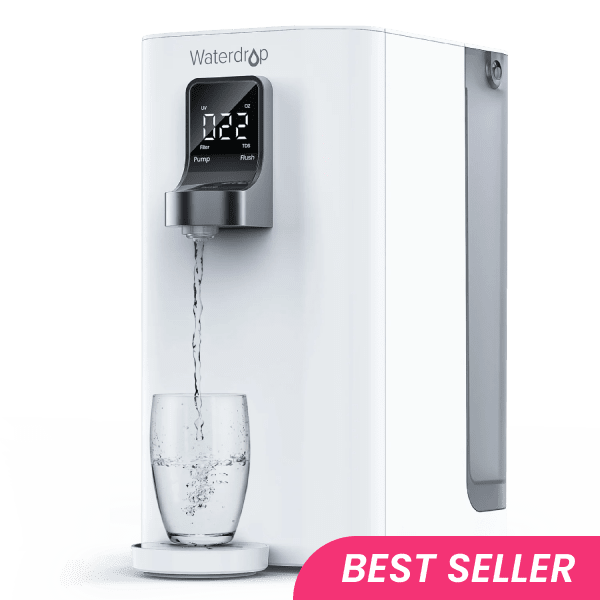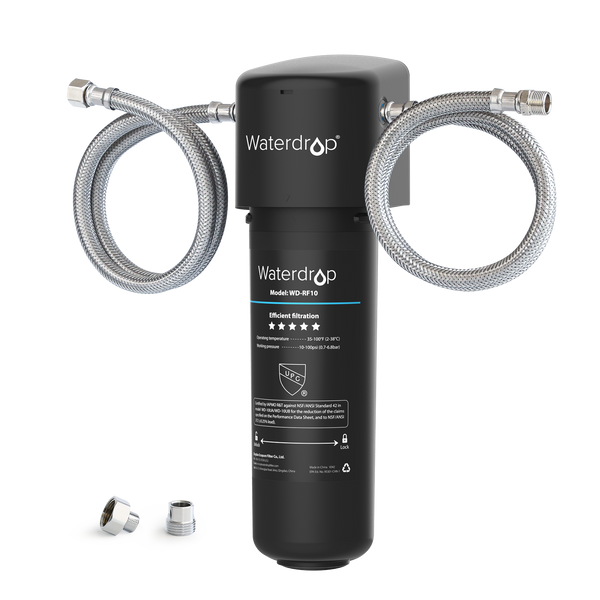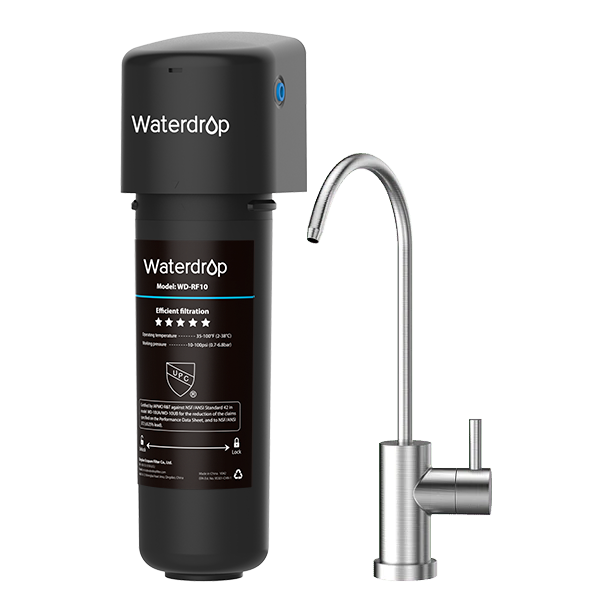Everything You Need to Know About Reverse Osmosis Systems
by Dr. Jonathan Doyle - Updated September 14, 2020
Reverse osmosis systems are designed to serve as an efficient and easy way of
getting clean water for household uses.
1.
Why Reverse Osmosis Is a Good Water Filtration Option?
Water filtration is not an entirely new concept – it is a proven method of getting
cleaner water from unclean water from various sources. Over the years, the water filtration system and process
have been refined and tweaked to offer users more convenience. One of these tweaks is the reverse osmosis water
filtration method. Others include ceramic filtration, ultraviolet filtration, and carbon
filtration, among others.
Compared to other water filtration systems and options, reverse
osmosis is a better method of providing clean and pure drinking water for households. The
reverse osmosis water filtration method relies on a semi-permeable membrane to filter out impurities from
drinking water. It is arguably the most efficient water purification technologies out there, capable of removing
toxins and dissolved
salts in water.
The reverse osmosis water filtration system is known to eliminate 99% of
contaminants found in water. These include:
- Chlorine and fluorine
- Lead, arsenic, chromium, radium, barium, cadmium
- Salts – Nitrates, sulphates, and others
- Sediments, dirt, and rust
- Heavy metals
- Parasites
- Volatile organic compounds (VOCs)
- Herbicides and pesticides
- Total dissolved solids (TDS)
- It also improves the taste of water while removing odor and color.
2.
How Does Reverse Osmosis (RO) Work?
Having established why reverse osmosis (RO) is a good water filtration system, let's move forward by
looking at how the reverse osmosis system works. In simple terms, Reverse Osmosis is the process of osmosis, but
in reverse. This is made possible with the introduction of a reverse osmosis membrane and the use of pressure.
Now, what is osmosis?
What is reverse osmosis?
A quick look at the osmosis definition will give us a clearer perspective of
reverse osmosis and how reverse osmosis water is derived. Osmosis can be defined as a naturally occurring migration of a weaker saline
solution to a strong saline solution. Osmosis occurs in nature during the absorption of water from the soil by
plant roots and the absorption of water from our blood by the kidneys.
Away from what is osmosis, let's discuss the reverse osmosis membrane and the
reverse osmosis process.
Reverse osmosis membrane
A reverse osmosis
membrane can be described as a semi-permeable membrane which the unclean water is 'pressured
through.' The membrane contains pores of a specific size. These pores are only big enough to allow the passage
of water molecules while blocking other foreign components like pyrogens, bacteria, organics, and dissolved
salts.
Reverse osmosis process
The reverse osmosis filtration process starts with the use of a high-pressure pump
to increase the pressure such that it is greater than the normal osmotic pressure. The extra pressure forces the
water to deionize or demineralize. Demineralization of the feed water (or source water)
separates pure water from contaminants, just before the combination passes through the semi-permeable RO
membrane.
When the feed water makes its way into the RO membrane under pressure, the
contaminants and impurities are prevented from passing through. Instead, they are forced to the reject stream or
brine stream. The clean part of the feed water, free of up to 99% of dissolved salts and contaminants, passes
through the semi-permeable RO membrane. The purified water is called the product water or permeate. The
contaminant part, which is unable to pass through the membrane, is called the concentrate.
Unlike the standard filtration process where the impurities are retained within the
filter meter, the cross-filtration method in reverse osmosis has two terminal ends or outlets for dispatching
both the contaminant and filtered water. The first outlet is where the filtered water passes, while the wastewater goes
through the second outlet. There is no accumulation of the wastewater because the system washes away
contaminants and keeps turbulence sufficiently high to keep the surface of the RO membrane clean.
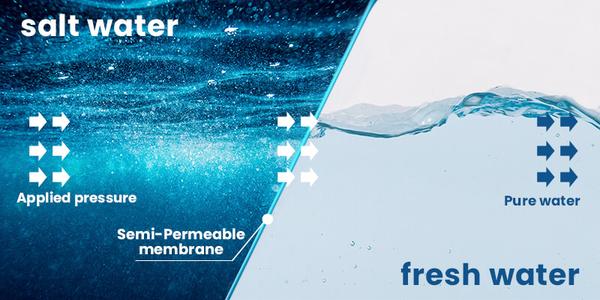
Basic components of the RO filter systems
The reverse osmosis membrane is just one of the many basic components you find in
RO filter systems. Others include:
- Cold water line valve, which is the water source for the RO system.
- Pre-filter(s), which takes in the water from the cold-water line valve. There may be multiple pre-filters in a system. Most pre-filter types include sediment filters and carbon filters. Sediment water filters are designed to remove sediments like dirt, sand, dust, and silts, while carbon water filters remove chlorine. Carbon filters may be absent in some RO water systems with a cellulose tri-acetate(CTA) membrane.
- Reverse osmosis membrane – as described above.
- Post-filter(s) – water from the RO storage tank goes through the post filter(s) before it gets to the RO faucet. These filters are mostly carbon, and this is the stage where odors and tastes are removed via post-filtration processes.
- Automatic shut off valve (ASOV) is included to stop water from entering an already full storage tank. It shuts off the flow of filtered water, and ultimately the flow of water into the drain. It opens when the pressure in the tank drops to allow the flow of water into the membrane and wastewater to the drain.
- Check valve, which ensures that pressurized filtered water in the storage tank is not forced back to the RO membrane when the ASOV has blocked the feed water pressure.
- Flow restrictor, for regulating the water flowing through the RO membrane. It sets the flow rate that is best for the highest quality drinking water and maintains the same. You can find it in the RO drain line tubing.
- Storage tank is where the filtered water is stored until it is drawn out of the faucet. It comes in different sizes and contains a bladder that maintains the right internal pressure when it is full.
- Faucet, commonly installed on the kitchen sink, is where you draw the filtered water from.
- The drain line is the line that connects the outlet end of the RO membrane to the drain. Contaminants that cannot make it through the RO membrane passes through the drain line out of the RO water system.
Are all RO water systems and filters the same?
No, all RO water systems and filters differ remarkably, even though they share the
same designs and components in most cases. Putting this into a clearer perspective, these systems differ in
three basic ways.
- The first is the number of water filters or stages.
- The second difference is the production capacity, i.e., how many gallons of water the system provides per day (GPD – gallons per day).
- The third and last difference is the quality of the components.
The most realistic way of assessing how excellent a RO water system will function
is to check the quality of its various parts. It is what separates the best systems from the mediocre ones. If the manufacturer uses the water filters
that filters fast, what you get is an optimally-performing unit and top-quality water.
Before you settle for a unit from any manufacturer, ensure that you buy from a
trusted manufacturer or company. The unit must have a good number of positive reviews and with the water filters
that filters fast, and other parts approved by the FDA or NSF. The technology in the unit must be modern and easy to operate and maintain. Check
this complete review guide to choose the RO system that suits you.
3.
What Contaminants Does Reverse Osmosis Remove? (RO)
As mentioned earlier, RO water systems are designed to remove contaminants from
water, making it fit for drinking and other household uses. This brings us to the question of what exact
contaminants is the RO process removing from the water? The list is a long one, but it comprises pyrogens, bacteria,
organics, colloids, particles, and dissolved salts or ions. RO has proven to remove up to 99% of these
impurities.
How does RO remove these impurities?
Reverse osmosis relies on the principles of size and charge in filtering out
contaminants from feed water. This is why the reverse osmosis membrane is designed to reject any particle with a
molecular weight of over 200, or a higher ionic charge (relative to water). Contaminants that record a
molecular weight of 200 and above will not pass through, the same for contaminants with higher ionic charge.
Let's relate this to real contaminants, for instance, Sodium. A sodium ion with a
single charge or a calcium ion with two charges will pass through the RO membrane. Gases like CO2 will always
pass through the RO water system because of their lower molecular weight and higher ionic charges. The
membrane's inability to filter out gasses means the filtered water or permeate water will have a below-average
pH level, considering that
the unfiltered CO2 ends up as carbonic acid.
What happens to the contaminants that fail to go through the membrane?
Contaminants that could not make it through the membrane are called concentrates.
They are discharged via the reject stream down to the drain. Alternatively, the concentrates can be recycled.
i.e., sent back into the feed water supply. This is economic and helps to save water.
If you have ground, surface, or brackish water, reverse osmosis will come really
handy. This is why industries like food and beverages, boiler feed water, pharmaceutical, semiconductor manufacturers, and others rely on the
RO system to turn unusable feed water into usable permeate water.
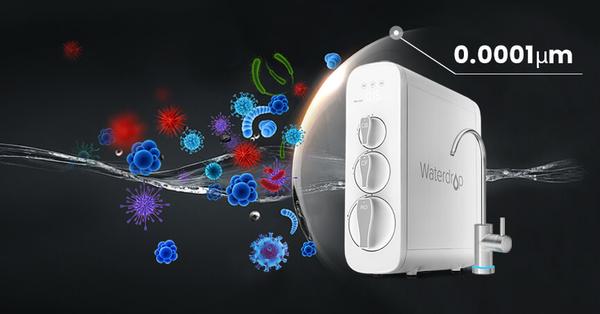
4.
What Is the Difference Between Passes and Stages in a Reverse Osmosis (RO) System?
There are different stages in a RO water
system – the same with water filters. As a RO user, you will come across the terms - 'stage' and 'pass'
regularly, so, it is essential to know what they mean and how they are used. There are 1-stage RO system,
2-stage RO system, single pass RO, and double pass RO stages.
The 1- and 2-stage RO system is function differently. The one-stage RO system is
designed to allow the entry of water into the RO system as one stream. But the same water exits the stream as
either the permeate water or concentrate. On the other hand, the two-stage is designed to use
the concentrate from its stage one as its feed water. It also combines the permeate water from the stage one
with the permeate water from stage two to ensure improved recovery. So, the more the stages, the better the
system's recovery.
The single-pass RO and double pass RO are also different. If we consider or assume
a pass to be an independent RO water system, then a double pass RO system can be explained as a setup where the
permeate from the first pass is used as the feed water for the second pass. This way, the permeate produced is
of higher quality; after all, it has passed through two RO systems.
Another advantage of the double pass RO is the removal of CO2 gas. This is achieved with the caustic injection between the Pass 1 and
Pass 2 to increase the pH of the first pass permeate water, which in turn conditions it for better rejection by
the RO membranes in the second pass.
What factors affect the performance of RO systems?
That a RO water system meets all the conditions highlighted in Section 2 of
this post does not translate to its optimal performance. There are a couple of other factors that affect the
performance of RO systems. These include pressure, temperature, recovery, and salt concentration.
- Pressure: The pressure of the feed water must be increased to increase the permeate flux and decrease the permeate's dissolved solid content.
- Temperature: An increase in temperature will cause the salt flow and permeate flux to increase.
- Recovery is the relation between the feed water pressure and the permeate flux. An increase in percentage recovery will increase the natural osmotic pressure and the concentration of the salts in the residual feed. This means the salt retention will decrease.
- Salt concentration of the feed water increases with osmotic pressure. Provided the pressure remains unchanged, an increase in salt concentration will cause a lower membrane water flux.
pH tolerance may also play a part. However, its effects vary widely across
different RO membrane types.
Operating conditions and performance data of a RO membrane
Below is the operating conditions and performance data of a RO membrane;
Water supply conditions
:Incoming water requirements to RO water system with typical TFC/TFM membrane:
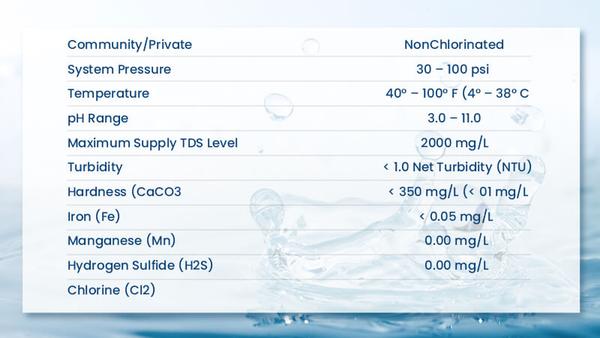
Incoming water requirements to RO water system with CTA membrane:
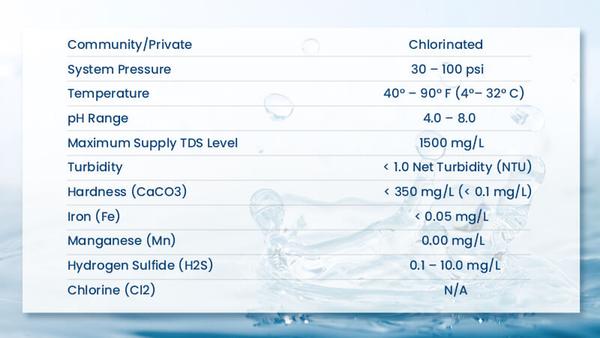
Performance data:

Definitions of abbreviations:
- CTA - cellulose tri-acetate - membrane is chlorine tolerant
- TFC - thin film composite- not chlorine tolerant but has a higher production capacity
- psi - pounds per square inch
- TDS - total dissolved solids
- mg/L - milligrams per liter
- gpg - grains per gallon
- NTU - nephelometric turbidity units
5.
Role of a RO Storage Tank?
The primary role of a storage tank is to store water and it is not any different in
the case of Reverse Osmosis systems. What an RO storage tank does is to store reverse
osmosis water in abundance until there is a need for it. The reverse osmosis tank wouldn't have
been a requirement if the water filtration system is designed to be fast with its operations, that's why now
there are tankless reverse osmosis systems on the market. But at a production speed of three ounces of water in
one minute or five minutes for a glass of water, there is a need for a fix. The storage tank is the fix, so a
tank RO system is not a bad choice.
With the water already filtered and stored in the storage tank, it takes only a few
seconds to fill a glass. These tanks are usually pressured tanks, considering their point-of-use applications.
However, their hydropneumatic nature means they deliver pressurized water without using a booster pump. They are
available in different sizes, but most sizes will fit under your kitchen counter.
6.
Reverse Osmosis and Water Wastage
One question potential RO owners and operators have always asked is if
reverse osmosis wastes water. The answer is no. While RO systems produce wastewater product, which is
collected in the drain, the same is recycled. This means that the wastewater product is returned to the water
treatment plant through the sewers.
The wastewater product is not ideal for domestic use, such as drinking, cooking, or
bathing. This is because it contains higher levels of contaminants. However, the contaminated water is returned
into the treatment plant and its byproduct deployed into other applications, such as cooling and flushing in
industrial processes.
For households, the water can be diverted from the drain into household applications like laundry, gardening, household cleaning, car washing,
and flushing toilets.
Is it possible to reduce wastewater?
For every gallon of water filtered by the RO water system, four gallons of
wastewater goes down the drain. Hence, there is an important need to reduce wastewater. It is possible to reduce
wastewater by applying some simple hacks:
-You can redirect the wastewater to where they can be used. So, in the long run, it
helps to reduce the amount of water you draw from the supply and from the feed water storage.
Is there any difference between reverse osmosis and bottled water?
Unlike RO water, mineral water retains minerals like calcium and sodium. Feed water
lacks these minerals because they have been removed during the RO purification process. But this is not a problem. The body only requires water for key
functions like organ function, joint lubrication, and hydration. These functions do not require the missing
minerals in the RO filtered water.
Better still, the body can get these minerals from food sources. Veggies and fruits
are known primary sources of essential minerals. While drinking mineral content is not entirely bad, it is vital
to ensure that the TDS in such water is not above 500 parts per million (EPA recommendation).
Is reverse osmosis good for the environment?
Plastics are one of the most prominent pollutants harming
our environment at the moment. The non-degradable nature of plastic means they cannot be broken down naturally for
several years. This has led to considerable depletion of aquatic life and the overall ecosystem.
RO reduces the need for and dependence on plastics, hence contributing to a better
and safer environment. However, producing reverse osmosis water at home means you can stop buying bottled water. This reduces the amount of plastic waste resulting from
bottled water purchases.
Based on these points, it is safe to say that RO water filtration systems are
environmental-friendly.
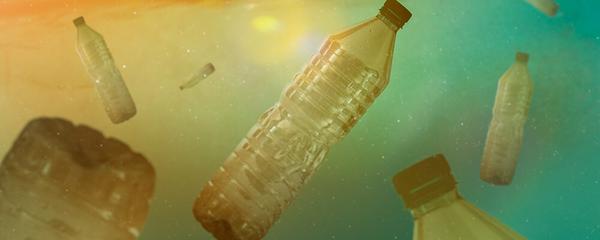
7.
Is RO Water Good for You?
Reverse osmosis, as a filtration process, eliminates contaminants and impurities
from feed water to produce the permeate water. These impurities include sediments, heavy
metals, pesticides, bacteria, and other harmful materials. The permeate water is also the
drinkable RO water.
That being said, it is essential to note that the reverse osmosis filtration
process also removes some minerals from the water. The minerals, including salt, calcium,
and magnesium, are not harmful components of water. Rather, they are known as important precursors for the
body's processes.
With these minerals removed from the reverse osmosis water, you may want to ask
that how will the body get these minerals? These crucial salts and minerals are present in foods and supplements.
Therefore, missing them in reverse osmosis water is not a problem because we will most likely get them in foods
and supplements.
Is the removal of these minerals enough reason to stop drinking RO water? The
answer is NO! Despite the absence of these essential salts and minerals, the reverse osmosis water is way
better, safer, and more beneficial to the body than polluted,
unfiltered water. Polluted water still contains heavy metals, pesticides, and bacteria. The consumption
may lead to significant health complications like cancer, dementia, congenital
disabilities in the long run.
This does not necessarily translate to the fact that reverse osmosis filtered water
is good. The water is just water required by the body to function optimally. But if you have to choose between
drinking unfiltered water with contaminants and reverse osmosis filtered water, the latter
is obviously the safer and healthier option.
So, yes, reverse osmosis water is absolutely good for you.

8.
Where to Use a Reverse Osmosis System?
Reverse osmosis systems are designed for use in a wide range of areas where water
purification is needed. These areas can be classified as either household or industrial applications. Let's take
a closer look at some of these applications below:
Industrial applications
The reverse osmosis system will fit into almost any of these settings where clean
water is required for operation. For instance, RO water filter systems come handy in wastewater treatment and
the production of ultrapure water. Below are few industrial applications of RO systems:
- Boiler feed-water treatment – RO helps to reduce the amounts of solids in waters before they are sent to the boilers for various uses.
- Pharmaceuticals– RO helps to achieve the U.S. Pharmacopeia (USP) water standards for the industry.
- Food and Beverages – RO water filter systems help to reduce contaminants in both liquids and solids.
- Semiconductors– RO systems come handy in the treatment of water to achieve ultrapure water.
- Metal finishing– RO systems are used in various metal industry operations like electroplating, black dye production, and nickel acetate seal productions.
- Power generation – RO membrane filtration is the safest water purification technique used in the production of high-purity water, which is a crucial requirement ins team production.
Getting pure water from RO water filter systems for industrial use comes with
environmental benefits, reduced costs, health, safety, and easy maintenance.

Household applications
RO systems have found important applications domestically. Below are a couple of
areas of the household setting where RO systems come really handy:
- Ice machines - Ice undergoes the same filtration procedure as the drinking water, after all, it is the filtered water from the reverse osmosis system that forms the ice. Most refrigerators come with a built-in ice machine. You only need to get the refrigerator close to the kitchen sink, so that it is easy to link it with the RO unit via a designated portal at the back of the ice machine.
- Faucets - This is the most common household application of reverse osmosis systems. RO systems are installed under the sink – under sink water filter system - where they work and dispense the filtered water via the designated kitchen faucet. The installation is ideal for the under-the-sink position because it is less obstructive there. Plus, it is easier to access for maintenance in that position.
- Well water - One of the foremost water sources humans had to rely on is well water. Well water used to be absolutely safe for drinking – at least two to three centuries back, but it is not the same nowadays. The continuous use of pesticides and mining activities have made groundwater contaminated and harmful for drinking. Reverse osmosis works well to provide cleaner and safer water from well water feeds. However, the parasites and bacteria will have to be removed via another treatment method.
- Aquariums– RO filtration removes all the minerals from water, making it suitable for your saltwater fish population. Although you may need a remineralizing filter to reintroduce the exact amount of salt required for these fishes. Alternatively, you may combine RO and deionization (RO/DI) to provide a highly pure water environment for the fishes.
- RVs– If you are looking to venture into wilderness locations for your RV adventure, then you should get a RO system. RO filtration, paired with ultraviolet disinfection, will provide safe drinking water to meet your remote needs.
Reverse osmosis system and water softener – The difference
The difference between a RO water filter system and a water softener is that it is
not designed to filter off harmful contaminants from water. Yes, a water
softener softens water by removing magnesium and calcium; the water it produces is best suited for
showering and washing clothes.
Although using it to treat hard water reduces the efficiency of the RO
membrane, Reverse Osmosis softens the water. The membrane will be due for a replacement sooner than normal. So,
it is better to use a water softener if you are dealing with hard water.
For better results, a combination of a water softener and RO system is advised. The
water softener removes the impurities that may stain your toilets, clothes, and shower, and refine the water
going into the RO membrane to ensure it doesn't cause clogging.
The water softener adds sodium to the water, but the RO removes it, so you have
perfectly clean water in the end.
9.
Performance and Design Calculations for Reverse Osmosis (RO) systems
There are a couple of parameters required for the accurate measurement of how a RO
water system performs. These include:
- Temperature
- Permeate flow
- Feed flow
- Permeate conductivity
- Feed conductivity
- Concentrate pressure
- Permeate pressure
- Feed pressure
Reverse osmosis (RO) performance trending and data normalization
You may want to ask that why do we collect RO system data points? They are needed
to assess the health of the RO membranes – a crucial part of the RO system, and they include the temperature,
quality, flows, and system pressures.
There is a proportional relationship between pressure and temperature. The lower
the temperature, the more viscous the water becomes. This reduces the permeate flow of the RO, considering that
more pressure is needed to push water through the membrane. The higher the temperature, the higher the RO
permeate flow.
Therefore, it is important to normalize the performance data for a RO system to
ensure adequate interpretation of flow variations. It is best to calculate, graph, and compare the salt
rejection, pressures, and normalized flows to the baseline data when troubleshooting issues. The same is
necessary when determining the ideal time for membrane inspection, cleaning, or replacement.
The most efficient way of assessing the true performance of the RO membrane is via
data normalization. The standards stipulate that a normalized change of +/- 15% from the baseline data warrants
immediate action. It is important to adhere to these standards to ensure prompt cleaning of the membrane and
keeping it running at optimal levels.
10.
Servicing and Maintenance of a RO System
Like every other essential system, the RO system needs to be serviced and
maintained as and when due. The best part, however, is that reverse osmosis filter systems are quite easy to
maintain. You spend minimally on its upkeep. Here are some aspects of RO system maintenance.
1.
Filter replacements
When should you replace the filters?
Filter
replacement is an important aspect of RO system maintenance. It is best to replace RO membranes and
filters after about 0.5-2 years of use. The exact interval will depend on the filter type, water usage volume,
and the quality of water you are filtering. Here is a standard schedule for filter replacement.
- Pre-filters – carbon and sediment filters - are due for replacement after 6-12 months.
- RO Membrane is due for replacement after 2-3 years.
- Post filter – carbon filters – are due for replacement after every 12 months.
You can get the exact replacement interval for your RO system water filter and
other parts by checking under the “SPECS” of each product. This section also contains any specific information
not included in the general guideline, or better still, the owner's manual.
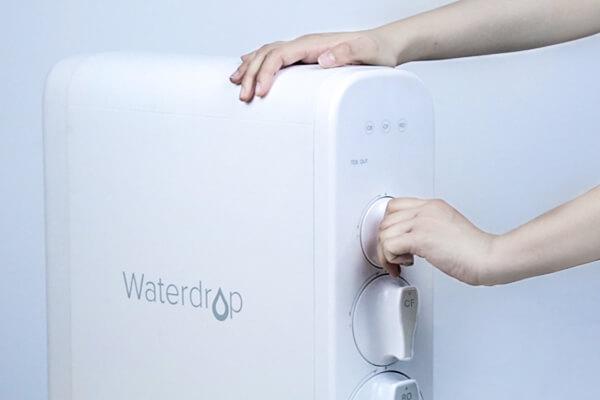
2.
Annual maintenance
The rule of thumb is that you sanitize the entire RO system and replace the filters
once every year. This is a simple DIY, but you can invite a water professional to handle the entire process if
you do not feel like it.
The lifespan of a RO system
The lifespan of a RO system depends on the level of maintenance and servicing, and
how frequently you replace the filters and membrane. If you adhere to best practices, you should be able to get
out 10-15 years of top performance from your RO system.
For better results, always get the water filters and membranes from certified
outlets. Wrong or sub-standard replacement filters may harm your RO system, reduce its efficiency, or shorten
its lifespan.
11.
Frequently Asked Questions – Reverse Osmosis (RO)
Below is a list of the most commonly asked questions by users and enthusiasts of
reverse osmosis filter systems. Each of the questions has been answered extensively to help you in the best
possible way.
Where is the reverse osmosis system stored?
The ideal location to install or store a RO system is under the kitchen sink.
This is why they are called the under sink water filter systems. Such under-counter reverse osmosis
systems come with a holding tank. The filtration process follows multiple phases, as listed below:
- First phase or pre-filtration phase is designed to filter out fine, suspended materials. This ensures that the membranes remain safe and unclogged.
- The second phase is the filtration phase where the chlorine is removed. It is essential to remove chlorine at this stage to ensure it doesn't damage the thin film material membranes.
- The third phase is where the semi-permeable membrane swings into action by filtering off various contaminants – including those harmful to the health. The water from the third phase – treated water - is sent into the pressurized storage tank.
- The fourth phase or the carbon post-filtration phase is the last stage of the RO process. During this stage, the carbon filter removes any aesthetic odor or taste. This is why it is popularly called the polishing or refining stage.
Can a RO system be connected to a fridge or ice machine?
Yes, it is possible to connect your RO system to the fridge or ice machine.
Ordinarily, you can plumb your under sink water filter systems to the incoming cold-water line, the drain, and
the independent faucet. There is also the possibility of plumbing it into the fridge and/or ice machine.
You will need to run a quarter-inch tube to link the RO unit to the fridge. Invite
a water professional to handle this for you. Such expert can also ascertain if you need to work on the water
pressure to make it up to what is required by the RO unit to function effectively with the ice machine or
fridge.
How much water can a RO system produce each day?
You can expect between 10 and 75 gallons of filtered water per day from your
Reverse Osmosis system. This output is equivalent to 45-340 liters of water daily. These expectations are for
under-counter reverse osmosis tanks with a height of 15 inches and a 12 inches diameter. The operational
pressure of such a RO system unit ranges between 40 and 100 psig.
Is a reverse osmosis system noisy?
No, a functional reverse osmosis system is not expected to make a noise. What you
should hear, at most, is a “gurgling” sound, which is a result of the flow of the wastewater to the drain from
the membrane. The design of the reverse osmosis filter unit ensures that the unit does not get messy. It does
this by flushing the wastewater away from the system via cross-flowing.
Sometimes, you may hear a hissing noise from your RO unit. This indicates a
problem with your unit, and you must immediately call in your local water treatment professional to have a look.
In this case, the possible culprits could be the water pressure, leaks, or air gaps.
Do you need electricity to operate RO?
Only large commercial or industrial RO systems require electricity to work. The
electricity is used in powering the pumps that feed the unit with feed water for the filtration process. An
under sink water filter system for residential use will run on water pressure from your household plumbing. So,
you get your clean, filtered water from the faucet or fridge without electricity.
How does RO water compare to bottled water?
Water from a reverse osmosis water filter unit is mostly preferred to bottled
water. Why? The carbon filtration phase in RO systems is designed to remove contaminants like herbicides, pesticides, arsenic, chloramines, and chlorine. In the end, the filtered water is free of harmful components
and foul odor or taste, making it safe and suitable for drinking.
The great taste is due to the deposit of trace amounts of minerals and salts by the
filtration process of a RO system. So, while the distilled bottled water has a somewhat flat taste, the filtered
water tastes much better. Lastly, drinking RO-filtered water means you spend less on bottled
water. When you buy less bottled water units, the environment is less polluted.
Is a RO system worth it?
For all intent and purposes, getting a RO system unit is a wise decisions a
homeowner can make. It does not only provide safer and better-tasting drinking water but also saves costs
significantly. For instance, a family of four can save up to 30 cents on water expenses per day with the best
water filter unit.
The average amount an American spends on bottled water is $100 per head ($400 for
four heads). The operational cost of a reverse osmosis water filter unit is about $100 per year, so you save up
to $300 annually on water costs. This is in addition to the vital health benefits that come with reverse osmosis
water. Drinking filtered, pure, and better-tasting water does a lot of good for your body system.
For these reasons, a reverse osmosis water filter system is a worthy investment.
Will reverse osmosis remove minerals that are necessary for a healthy body from the water?
The
mineral content in tap water usually varies, depending on the water source and the city you stay
in. When present in a heavy amount, the mineral content alters the smell and taste of tap water. Subjecting such
water to a reverse osmosis water filter eliminates most of the minerals in the water. The result is cleaner
drinking water with improved aesthetics.
The inorganic state of the minerals in water means that our body cannot digest
them. So, removing them from the reverse osmosis water does not make the water unhealthy or unfit for
consumption. We made up for this with the foods we eat, which are the main source of these minerals. The human
body is conditioned to better absorb and digest these minerals from the food.
12.
Reverse Osmosis Water Filter Systems for the Home
Are you considering the good way to get filtered drinking water for your domestic
consumption? You can refer to the reviews of the top
systems to make your purchase decision. Check our store for our best-selling reverse osmosis systems.
Whatever your budget and preferences are, you will find the one fit from our catalog.
13. Conclusion
Water has always been and remains a paramount requirement for the well being of all
humans. With more water issues surfacing, accessing clean and drinkable water is fast becoming increasingly
difficult. Fortunately, a reverse osmosis system is a easy and efficient way of turning unclean, contaminated
water into clean, safe drinking water.
The value we derive from reverse osmosis systems cannot be overemphasized. The
system is designed to efficiently convert unclean water to drinking water by subjecting the former to a few
filtration processes. And it does this excellently with very minimal input from the user.
From the operational processes and stages to the components and how they work, this
post has discussed reverse osmosis systems extensively and practically. We are convinced that you are better
informed about RO systems. You are also in a better position to make the right purchasing decision and put in
the best maintenance efforts to keep your water filter unit functioning optimally.
Reverse osmosis technology is also suited for industrial applications, especially
when and where deionized and demineralized water is needed. Whether you are in the market for a domestic under
sink water filter system or reverse osmosis system industrial use, you can rest assured that you are making a
smart and cost-effective decision, both in the long and short run.
If you still want to know more about the reverse osmosis system or just anything
about water purifier, do feel free to contact us. Waterdrop also takes pride of
providing various types of RO to satisfy your needs, if you are interested in our products, you can always visit
our RO
collection page and learn the detailed features of each system.
Contaminants Detected in Fruitland Water Special Service District
30
Contaminants
EXCEED EWG HEALTH GUIDELINES
EXCEED EWG HEALTH GUIDELINES
30 Total Contaminants in Your Water
Water Provider
Fruitland Water Special Service DistrictPopulation Affected
120,000Water Source
Ground waterExceeds Guidelines
Others Detected





